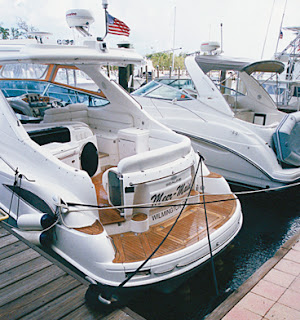This information offered by Frank Ramos of Intercoastal Financial Group, LLC is featured in my September "Waterways" newsletter but for those who don't receive that publication, I am featuring it here also.
Frank has worked in yacht financing for 25 years and I highly recommend him for his knowledge and his service. Take a look at what he has to say about the current market.
* * * * * *
If you are in the market to purchase a yacht, you might consider financing the cost of the acquisition. Interest rates are at historical lows, not only for home mortgages and auto loans, but for yacht loans too. Lenders will finance up to 80% of the purchase price and offer terms up to 20 years. Closing costs also are very minimal with a boat loan. Another advantage to financing a yacht purchase is the tax deductibility of the interest cost since yachts can be considered a second home (please consult your accountant to see if you are eligible).
The following are examples of current rates and programs available in today’s market:
1) 5.37% - fixed rate up to 20 years for loans $100,000 to $499,999. The monthly payment factor is $6.81 per $1,000 you borrow. For example, on a $100,000 loan, the monthly payment would equate to $681.
2) 5.12% - fixed rate for 20 years for loans $500,000 and over. The monthly payment factor = $6.67/$1,000.
Adjustable rates are also available for yacht loans. Currently, there is a 3-year fixed rate offered at 4.50% for loans $100,000 and over with a 20 year term. This might be a good financing option if you have a short term plan in mind for the boat or loan (perhaps this purchase is an interim boat while a larger boat purchase is in the near future, you plan to sell some assets or your company, or a lifestyle change such as retirement is in the horizon).
Ok, so it’s a good time to finance a boat purchase but how difficult is securing a loan going to be in today’s lending environment? Well, I can say that in my 25 years of financing boats, the credit standards have not really changed that much. Lenders will look for applicants to have sufficient cashflow to support the new boat loan as well as existing obligations, for those who have adequate liquid assets to make the down payment along with a ‘cushion” leftover (usually 20-30% of the loan amount), and who show a good credit history. Assuming you meet these criteria, approvals are usually available in 3 to 4 days.
Hopefully this information is helpful when considering your next purchase. Please contact me for additional details on current rates and programs and/or questions regarding your yacht financing needs.
All the best,
Frank Ramos
124-A North 2nd ST
Ft. Pierce, FL 34950
Cell: 954.614.3888
Fax: 772.264.2297
Email: frank@boatloans.net






















